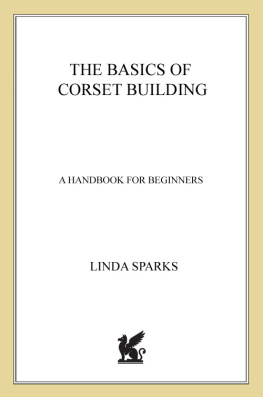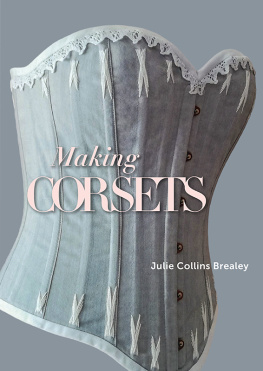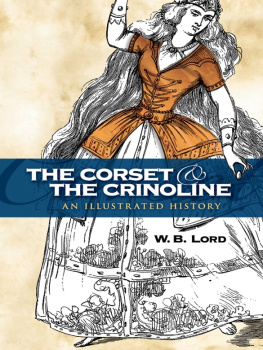THE BASICS OF
CORSET BUILDING

A HANDBOOK FOR BEGINNERS
BY LINDA SPARKS
 ST. MARTINS GRIFFIN
ST. MARTINS GRIFFIN  NEW YORK
NEW YORK
The author and publisher have provided this e-book to you for your personal use only. You may not make this e-book publicly available in any way. Copyright infringement is against the law. If you believe the copy of this e-book you are reading infringes on the authors copyright, please notify the publisher at: us.macmillanusa.com/piracy.
THE BASICS OF CORSET BUILDING . Copyright 2005 by Linda Sparks. Illustrations and photographs 2005 by Linda Sparks. All rights reserved. For information, address St. Martins Press, 175 Fifth Avenue, New York, N.Y. 10010.
www.stmartins.com
The written instructions, photographs, designs, patterns, and projects in this volume are intended for the personal use of the reader and may be reproduced for that purpose only.
Illustrations by Vanessa Palmer, Linda Sparks, and Nancy Hastings-Trew
Photographs by Linda Sparks
Layout by hypertext digital publishing
Edited by Janet Dimond
ISBN-13: 978-0-312-53573-5
ISBN-10: 0-312-53573-2
First published in Canada
First U.S. Edition: January 2009
eISBN 9781429994279
Special Thanks to
Tim Sparks for always supporting me.
Dedicated to Vera FitzGerald
and grandmothers everywhere you have the power to inspire.
Foreword
This book has been written to explain in illustrated detail the process of building a corset. It was written for those people who have never made a corset but do have basic sewing skills you can sew a straight line. Sewing a corset isnt quite accurate as the process is more involved than just sewing. You have to know how to work with . Consider using what you learn here on any project that requires structure.

My background is theatre and this means I look for quick and efficient ways to make durable long-wearing garments. This book doesnt discuss couturier methods you can easily implement the techniques. Once you have the basic understanding of how a corset is put together, you can easily include your own finishing style, appliqus, and design details to create your own signature style corset. This book is just the beginning!
Commercial corset patterns by Laughing Moon and Simplicity are used for all of our samples in this book. You should be able to find these patterns easily. I strongly recommend using either the Laughing Moon (Dore) or Simplicity (9769) corset patterns for your first corset as both are excellent patterns and, since theyre both discussed here, youll have all the information you need for a successful project. They also both lend themselves well to fitting and styling.
There is always more than one way to do anything and this book will describe only a few ways to build a corset but that doesnt mean there are no other ways. You may incorporate construction methods youve learned previously, combine steps from each of these three methods, or have a totally different approach. These methods are described to give you a starting point and a basic understanding of how to build your first corset. Once youve built one I hope youll be inspired to experiment with other materials and techniques. You dont need a lot of sewing experience to build a corset, but you do need patience, organizational ability, puzzle-solving skills and the ability to sew a straight line is a huge asset.
A corset isnt a difficult garment to sew, but its a challenge to build as there are so many pieces and so much hardware. Approach your first corset with time, patience, and an understanding that it wont be a make it today, wear it tonight project.
Note: All terms in bold are linked to their explanations in the Glossary. And always read all the instructions step by step the first time.
Linda Sparks
Corset Map

A corset has several components and some of these wont be familiar to you. All of the corset building techniques outlined in this book will refer to these parts and you can refer to this illustration as your corset map. This illustration indicates what is what and what goes where. Not all corsets will be composed of all of the parts shown here but every corset will include some of these elements. All parts labeled on the corset map will be described in depth in other chapters within this book.
Section One: Tools and Materials for Corset Building
1. Tools

Our discussion wont include machines, only hand-held tools. How many tools you have in your sewing kit will depend on what you sew most often. Most of us have and scissors the basics. To build a corset you need all of these and a bit more. For those of you who are new to sewing well start with the basic tools listed above, then expand upon them and add a few new ones. Details on exactly how the tools are used will be found in other chapters. This list is to give you an idea of what tools you may need to acquire.
Thimble
Everyone knows what one looks like but its surprising how many people dont know how or when to use one.

Why should you use a thimble? Because you cant sew efficiently without one and doing so can be dangerous; particularly when sewing heavy fabric that may be difficult to get a needle through.
The thimble protects the middle finger of your sewing hand and gives you more power to push the needle through the fabric. Proper sewing technique requires that you enter the needle into the fabric while holding the needle between forefinger and thumb (A) and then follow through by pushing the needle through the fabric using your middle finger (B). The head of the needle can be very fine and even thicker needles can still puncture your finger before they go through all layers of fabric if you dont use a thimble for protection. Puncturing your finger will be painful, but worse; it will cause you to bleed and that means youll get blood on the corset.

If you do happen to prick your finger and get blood on the garment, there is a very easy solution.
Blood is inclined to leave a permanent stain unless you use your saliva to dissolve it. Yes, its true your saliva will remove the bloodstain but not if you try this after trying any other options. And only your saliva will dissolve your bloodstain so no one can help you with this. Simply spitting on the garment looks a bit vulgar, so take a yard or meter of thread, ball it up and chew it for a moment, let it get saturated, and then dab the stain with the saturated balled-up wad of thread and watch the bloodstain disappear. If you find this hard to believe, try it.












 ST. MARTINS GRIFFIN
ST. MARTINS GRIFFIN  NEW YORK
NEW YORK



